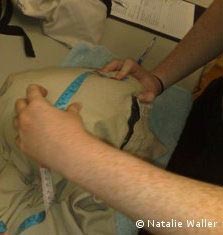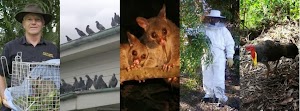Peter the Possum Man was involved in a university research project a few years ago investigating the Welfare of Evicted Brushtail Possums from ceiling cavities in Brisbane.
During 2009 & 2010 we worked with a university honours student, Natalie Waller from UQ Gatton, School of Animal Studies. Her thesis subject was; Does evicting common brushtail possums (Trichosurus vulpecula) from roofs compromise the welfare of the animals??.
This was a manipulative experiment to determine if the eviction of female Brushtail possums from roofs compromises their welfare by determining if evicted possums:
1. relocate to another den site outside the pre-eviction home range;
2. lose body weight after been removed from the roof; and
3. change their home range after eviction.

Measuring Size of Possum
Possum With Radio Tracking Collar
The student used radio collars to track the Brushtail possums for two weeks before and two weeks after they were evicted from the roof to determine their home range.
The thesis is complete and these are some of the main findings:
Female brushtail possums in Brisbane have a very small home range often only 4 to 8 household properties (averaging 0.7 hectares). The size of the home range appeared to be determined by the amount of vegetation within the space.
When the possum was evicted from the house it stayed in the same area usually only 2 or 3 houses away and typically moved under 70 meters from the original den.
Only two possums lost weight which could be associated with stress or maybe was due to having a large back rider offspring. There was no significant change in body weights between evicted and control (animals not evicted) possums. Surprisingly many of the evicted possums actually put weight on.
A few of the trial properties had possum boxes installed in the garden. It was observed that the possums evicted from these properties preferred to go into other den sites and did not use the possum boxes during the first few weeks.
The average number of possums captured per roof was 1.3, 44% male, 56% female.
The main welfare issue raised was injuries to possums noses sustained from capture in the metal cage traps. We now get all our new cages in a smaller mesh which reduces this concern.
The possums moved very small distances from their original roof space. Most possums moved to other roofs, a few possums moved to garages and one to a palm tree right beside the original roof the possum was evicted from.
We were glad to have the results that this honours study demonstrated that eviction of possums from roofs in Brisbane does not compromise the welfare of female brushtail possums. In fact it demonstrated that most of the possums know of several other places where they can safely go within 70 metres of their selected home.
Because possums are a native animal they are protected by law, and because they are territorial it is illegal to relocate them. You must also have a permit to cage or trap a possum. Our company has the relevant wildlife permit to cage possums and remove them from inside buildings but they must be released nearby.
Relocation is pointless anyway as there are so many possums is Brisbane, that is why Peter the Possum Man offers the long term solution of not only removing the possum from the roof, but also repairing the entry points with a 12 month warranty to ensure we have solved the problem.
More recently we are aware of studies that have been done on ultrasonics and possums see this page for more information about the results.







